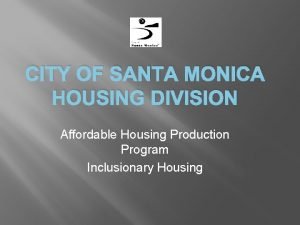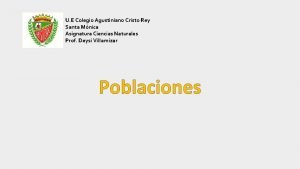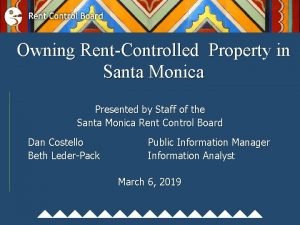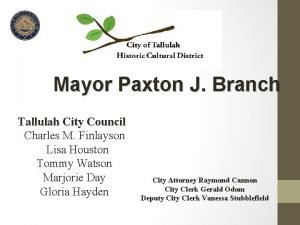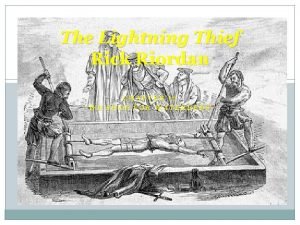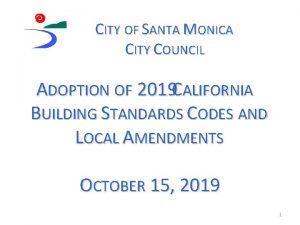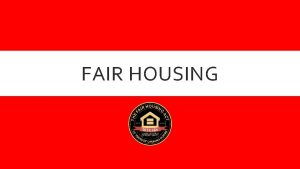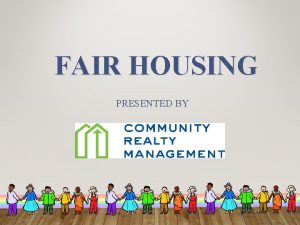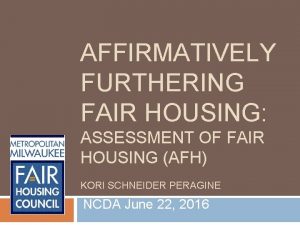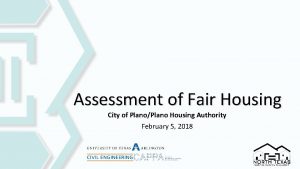City of Santa Monica Assessment of Fair Housing








- Slides: 8

City of Santa Monica Assessment of Fair Housing Natalie Verlinich Nigel Wallace City of Santa Monica Housing Division Diane Glauber Director, Fair Housing and Community Development Lawyers’ Committee for Civil Rights Under Law November 2019

Purpose of the AFFH Rule u. Set up a framework for taking meaningful actions to affirmatively further fair housing u. Fair housing planning rule u Clarify existing fair housing obligations u Set locally-determined fair housing priorities and goals u Connect fair housing planning to subsequent community planning and development via the Consolidated Plan, Annual Action Plans, and PHA Plans (as applicable) AFFH Rule Guidebook: Preface: Empowering Program Participants in Fair Housing Planning

The Fair Housing Act u The Fair Housing Act (42 U. S. C. 3604 & 3608) prohibits discrimination in the sale, rental, and financing of dwellings, and in other real estate-related transactions because of the following personal characteristics: › › › › Race; Color; Religion; Sex; Familial status; National origin; or Disability. u The Fair housing Act also requires that HUD administer programs and activities relating to housing and urban development in a manner that affirmatively furthers the policies of the Act. HUD must do more than simply not discriminate itself; the Act reflects the desire to have HUD use its grant programs to assist in ending discrimination and segregation, to the point where the supply of genuinely open housing increases. u The California Fair Employment and Housing Act protects against discrimination based on additional characteristics including age, gender identity and expression, sexual orientation, marital status, ancestry, source of income, and genetic information.

Community Participation Focus Groups 1. Developers and Landlords 2. Housing and Homelessness 3. Civil Rights and Legal Advocacy 4. Social Services 5. Residents and Community Organizations 6. Government Agencies Community Meetings Public Hearings

Draft Preliminary Recommendations Goal 1: Increase the supply of affordable housing u Allocate city-owned land for affordable housing. u Explore the reduction in the cost of permits for nonprofit housing developers. u Reduce parking requirements for supportive housing developments. u Explore zoning changes to facilitate the development of affordable housing in areas without publicly supported housing developments. u Further leverage City funds in the development of affordable social housing.

Draft Preliminary Recommendations Goal 2: Preserve the existing stock of affordable rental housing and rent stabilized housing u Explore the development of a citywide no-net-loss of affordable housing policy that is included in land-use plans, local laws, community plans, and Requests for Proposals for funding for affordable housing. u Study the seismic upgrade needs of affordable multifamily housing buildings and explore the creation of grants or low-interest loans for these upgrades u Strengthen and expand education and outreach to tenants and owners of affordable rental housing at risk of conversion to market rents and provide options for incentivizing small landlords to maintain affordability. u Expand the city’s flexible rent subsidy program to stabilize low-income renters.

Draft Preliminary Recommendations Goal 3: Prevent displacement of low- and moderateincome residents. u Explore the feasibility of a “Right to Counsel” Ordinance to protect tenants’ legal rights. u Study and explore the development of a narrow, partial residency preference targeting residents of the Pico neighborhood for affordable housing programs or funding other than the Housing Choice Voucher Program. u Explore reducing the number of work hours required to qualify for the Live/Work preference from 36 hours per week to 25 hours per week to make programs more inclusive for part-time workers.

Draft Preliminary Recommendations Goal 4: Increase community integration for persons with disabilities u Conduct targeted outreach and provide tenant application assistance and support to persons with disabilities, including individuals transitioning from institutional settings and individuals who are at risk of institutionalization. u Require at least 10% of total units in all newly constructed multi-family developments receiving public funds where City funds are leveraged with Low-Income Housing Tax Credits to be accessible to persons with mobility disabilities and at least 4% of total units to be accessible for persons with hearing and/or vision disabilities. u Provide a point of contact for a dedicated full-time ADA Coordinator to track and maintain a list of ADA-accessible housing units and coordinate the housing needs of people with disabilities. Additional responsibilities would include assessing risk of violations, coordinating with City departments, and providing education and instruction. u Explore strategies for allowing occupancy of City-funded affordable senior housing by non-elderly persons with disabilities through compliance with the criteria for “housing for older persons” listed in 42 U. S. C. § 3607(b)(2)(C).
